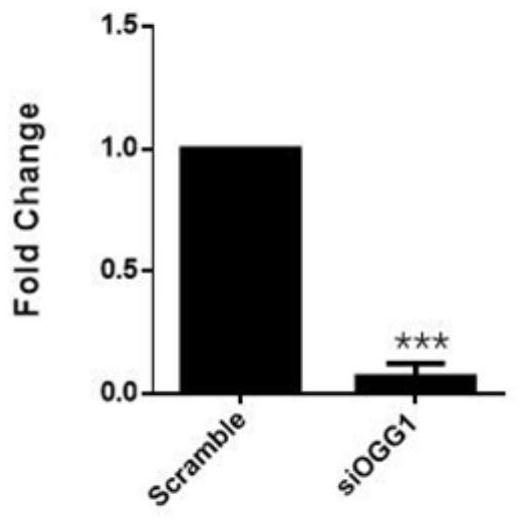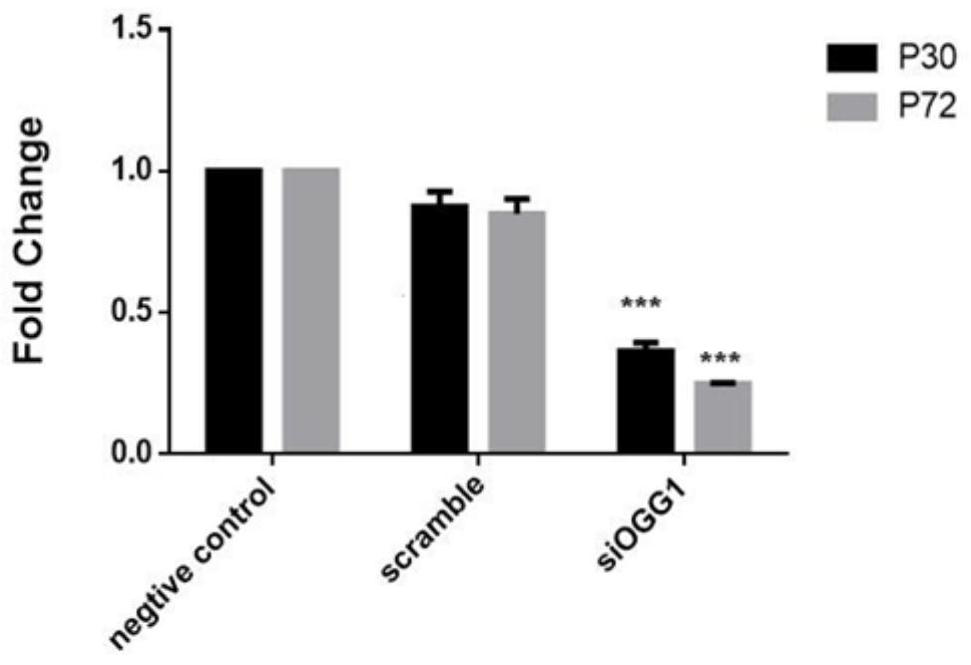New application of OGG1 small-molecule inhibitor in treating African swine fever
A small molecule inhibitor, African swine fever technology, applied in the field of African swine fever, OGG1 small molecule inhibitors, can solve the problems of vaccines and antiviral drugs without African swine virus, affecting pork supply and export trade, etc., reaching Effects of inhibiting early infection and inhibiting proliferation
- Summary
- Abstract
- Description
- Claims
- Application Information
AI Technical Summary
Problems solved by technology
Method used
Image
Examples
Embodiment 1
[0051] Example 1 Verification of siRNA interference effect of OGG1
[0052] 1. Protein level detection process
[0053] (1) PAM cells with 2×10 6 Spread in 6-well plates and culture for 24 hours;
[0054] (2) Collect the cells, discard the supernatant by centrifugation, and wash once with PBS;
[0055] (3) Resuspend the interference group cells in 2ml of transfection reagent containing siRNA; the specific components are as follows:
[0056] Double-antibody-free 1640 medium, 1863 μL; Buffer, 120 μL; Reagent, 12 μL; siRNA, 5 μL; siRNA final concentration 50 nM; control group cells were resuspended in 2 mL double-antibody-free medium containing siNC, then inoculated into a 6-well plate, and interfered for 24 hours ;
[0057] (4) Collect the cells, discard the supernatant by centrifugation, add RIPA and lyse on ice for 30 min;
[0058] (5) Centrifuge the lysate at 4°C, 12000r for 15min, and collect the supernatant as the whole protein;
[0059] (6) To measure the protein con...
Embodiment 2
[0075] Example 2 Interfering with OGG1 inhibits ASFV proliferation
[0076] 1. Protein level detection process
[0077] The specific steps refer to the "1. Protein level detection process" in the above Example 1, wherein the step (8) antibody incubation is as follows: take out the nitrocellulose membrane and place it in TBST containing 5% skimmed milk powder for blocking for 1 hour, discard the blocking solution Then wash 3 times with TBST, 5 minutes each time, add p30 and p72 antibodies after membrane shearing, and incubate overnight at 4°C. The next day, wash 3 times with TBST, 5 minutes each time, incubate the secondary antibody of the corresponding species in the dark for 45 minutes, wash 3 times with TBST, 5 minutes each time, add the chromogenic solution in the dark, and use the system to scan the membrane. Band grayscale analysis.
[0078] 2. mRNA level detection process:
[0079] The specific steps refer to the "2.mRNA level detection process" in the above-mentioned...
Embodiment 3
[0083] Inhibition of adhesion to ASFV virus after embodiment 3 interferes with OGG1
[0084] 1. mRNA level detection process:
[0085] The specific steps refer to the "2.mRNA level detection process" in the above-mentioned embodiment 2, wherein, in the step (3) described in 2 in the embodiment 2, ASFV (MO=0.5) is added to the cells of the interference group and the control group Infection was performed at 4°C for 1 h.
[0086] 2. Results
[0087] After ASFV infected cells that interfered with the expression of OGG1, the results of ASFV virus adhesion were as follows: Image 6 As shown, the results show that RNA interference OGG1 can significantly inhibit the adhesion of ASFV virus.
PUM
 Login to View More
Login to View More Abstract
Description
Claims
Application Information
 Login to View More
Login to View More - R&D
- Intellectual Property
- Life Sciences
- Materials
- Tech Scout
- Unparalleled Data Quality
- Higher Quality Content
- 60% Fewer Hallucinations
Browse by: Latest US Patents, China's latest patents, Technical Efficacy Thesaurus, Application Domain, Technology Topic, Popular Technical Reports.
© 2025 PatSnap. All rights reserved.Legal|Privacy policy|Modern Slavery Act Transparency Statement|Sitemap|About US| Contact US: help@patsnap.com



